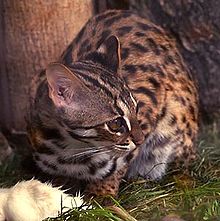|
List of mammals of Macau
This is a list of the mammal species recorded in Macau. There are 83 mammal species in Macau.[1] The following tags are used to highlight each species' conservation status as assessed by the International Union for Conservation of Nature:
Some species were assessed using an earlier set of criteria. Species assessed using this system have the following instead of near threatened and least concern categories:
Order: Sirenia (manatees and dugongs) Sirenia is an order of fully aquatic, herbivorous mammals that inhabit rivers, estuaries, coastal marine waters, swamps, and marine wetlands. All four species are endangered.
Order: Primates The order Primates contains humans and their closest relatives: lemurs, lorisoids, monkeys, and apes.
Order: Rodentia (mice, squirrels, etc)The order Rodentia is a large group of mammals. They have two incisors in the upper as well as in the lower jaw which grow continuously and must be kept worn down by gnawing. 
Order: Chiroptera (bats) The bats' most distinguishing feature is that their forelimbs are developed as wings, making them the only mammals capable of flight. Bat species account for about 50% of all mammals.
Order: Pholidota (pangolins) The order Pholidota comprises the eight species of pangolin. Pangolins are anteaters and have the powerful claws, elongated snout and long tongue seen in the other unrelated anteater species.
Order: Cetacea (whales) The order Cetacea includes whales, dolphins and porpoises. They are the mammals most fully adapted to aquatic life with a spindle-shaped nearly hairless body, protected by a thick layer of blubber, and forelimbs and tail modified to provide propulsion underwater.
Order: Artiodactyla (herbivores)  The order Artiodactyla in Macau are mainly herbivore which feed only on plant material, except wild boar. There are three types of herbivores (includes native and feral) in recent Hong Kong.
Order: Carnivora (carnivorans)  There are over 260 species of carnivorans, the majority of which eat meat as their primary dietary item. They have a characteristic skull shape and dentition.
See also
Notes
References
|
Portal di Ensiklopedia Dunia